NEONATOLOGY ON THE WEB
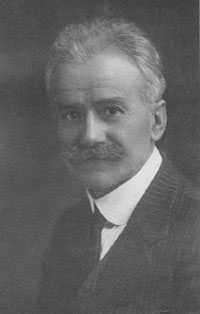
|
The Baby Incubators on the "Pike."
A Study of the Care of Premature Infants in Incubator
Hospitals Erected for Show Purposes.
Part 3.
By John Zahorsky, M.D.,
St. Louis, Mo.
St. Louis Courier of Medicine 32(2):65-80, February,
1905.
(Continued from page 13, January, 1905, Number).
|
The Nurses.
It is unnecessary to discuss the propriety of having only
well-trained nurses to take care of premature infants. When the
danger of sepsis to these little ones is considered, especially in an
incubator institution, only those trained in the principles of
medical and surgical asepsis should be permitted to serve. The
wet-nurses should have nothing to do with the incubators or their
inmates.
As to the number of nurses necessary, the exigencies of different
periods must decide. We had fourteen well-trained nurses. They worked
in three shifts, each eight hours long; hence, there were four or
five nurses on duty all the time. These nurses cared for twelve to
fifteen babies, nearly half of which were "graduates," that is,
babies out of the incubators. It will be seen that each nurse had
under her care from three to five babies. As a rule, there was such a
division of work that the nurse having the care of a very delicate
infant, which demanded much attention, at the same time supplied the
needs of older babies who needed less care.
It is a recognized rule in institutional nursing that the nurses
who feed the babies should not handle the napkins or bathe the
babies. This rule we did not follow, since rigid asepsis rendered it
unnecessary and it was found more satisfactory that individual nurses
look after all the wants of the infant.
The Transportation of the Infant.
The extreme susceptibility of the premature infant to atmospheric
changes in temperature make the problem of heat supply one of the
most important in their care. The protection of the newly born from
the loss of heat is so generally recognized that the family physician
or midwife usually makes some provision for its prevention. It is a
mistake to assume that these babies always die from temperature
reduction. In a few instances, when our physician arrived, the
premature infant had been kept so warm that its temperature a short
time after birth was over 100°.
Recognizing that the prevention of the initial heat-loss is most
important the management early made provisions to minimize this
danger. An ambulance and driver were provided which could be called
upon day or night. A receptacle, in the nature of a small portable
incubator, was utilized to keep the baby warm. The house physician
and one of the nurses was usually dispatched to get the infant when a
telephone message was received. Occasionally, due to a variety of
causes, the infant could not be reached for three or four hours, but
most commonly our physician, nurse and ambulance reached the
premature infant in less than two hours, nevertheless, the number of
infants for whom we were asked to send and had expired on arrival of
the ambulance was very large. It is true that after it became
generally known that the Incubator Institute was caring for all
premature babies free of charge, physicians, midwives and parents
would send for the baby ambulance for miscarriages of 4 1/2 to 6
months. Anything that moved was considered a sufficient subject to
send to the incubators. But we gladly made an effort even in the most
hopeless cases. One infant died on the way, many others which were in
a hopeless prematurity arrived in fair condition to die a few hours
later. During the three months of my service we received four infants
each weighing less than 900 grams in very good condition, but who
died shortly afterward.
As soon as the infant was reached, the rectal temperature was
taken and it was quickly examined as to evidence of disease. It was
then wrapped in cotton wool and placed into the portable incubator, a
description of which follows, for which I am indebted to Dr. Gordon:
Portable Incubator.
"This was designed for use in the ambulance and was made of
enameled tin with a glass top. It is 12 inches wide, 18 long and 16
inches high. At the bottom is a sliding drawer which is pulled out by
means of a handle. This is the bed and is composed of a strong wire
netting held in a frame: a thick layer of cotton is put next to the
wire netting, next a layer of several hot water bottles, next a still
thicker layer of absorbent cotton upon which the baby, well rolled in
cotton, lies. A thermometer lies beside the child. About 4 inches of
the top is composed of the enameled tin through which are two holes 1
inch in diameter for the exit of air. The rest of the top is composed
of a sliding glass door with a handle. The inlet of air was allowed
for by opening the bottom drawer a trifle. Around the entire
incubator goes an ordinary trunk strap which serves the double
purpose of a handle and to hold the drawer and top in place.
"In the ambulance the incubator rested not on the floor but on a
shelf suspended by springs and straps from the center of the roof of
the ambulance. Near the front end of this shelf was an opening 3
inches in diameter; the open end of the sliding drawer was put just
over this hole in the shelf, so there could be a free ingress of air.
On a trip the temperature of the incubator was maintained,
approximately at 92° to 94°."
The distance which the babies had to be carried was important. A
long ride always had a pernicious influence, even when carried in our
portable incubator. For example, Henry, gestation 7 1/2 months,
weight 1733 grams, was brought six miles at night over very rough,
unpaved streets and on arrival exhibited multitudinous hemorrhages
from the skin and mucous membrane.
Quite a large number of premature infants came from places outside
of St. Louis. Many times telegrams were received that Mr. ------ had
started with an infant, asking us to meet him at the station, and
although the ambulance never failed to be at the station only once
out of perhaps six or eight such calls did the baby arrive. Most
commonly the infant died after a short time and the parent would stop
at the first station and return home.
A few infants were brought to the incubator in fair condition,
wrapped in blankets, and during the warm weather such a method is
practicable.
We found it inexpedient to encourage physicians outside of St.
Louis to send babies to the institute.
The Rectal Temperature on Arrival.
As soon as the infant arrived its rectal temperature was taken and
if this was below 96.5° a warm bath at 98° was given to
restore the loss of heat, otherwise it was rubbed with warm oil,
dressed and placed in the incubator.
Budin has laid great stress on the prevention of the initial loss
of heat, and claims that of infants under 1500 grams with a
temperature less than 32° C., 98 per cent die. Most of our
infants arrived in good condition as regards the body temperature.
The accompanying Table I, shows this.
It will be seen that three infants arrived with a temperature
above normal; in all three instances the cause of this must have been
the overheating of the portable incubator, although one of these had
a temperature above normal when taken from home.
From all this I must conclude that the portable incubator should
have a temperature of 90 to 94° for infants under 1800 grams,
and 86 to 90° for infants weighing more than this. Of course,
the temperature of the baby when first seen, the thickness of the
clothing of the infant and the distance through which it is to be
conveyed must all be considered.
The Temperature of the Incubator.
In spite of much that has been written on this subject there is no
unanimity as to the temperature at which the incubator should be
kept. Heubner, in his recent textbook states that it has been found
that a temperature of 30° C. (86° F.) is the proper
temperature for premature infants, but such a general statement is
insufficient for practical guidance. No doubt some of the differences
in opinion may be attributed to the experience of physicians with
infants of different ages. Probably, too, the variable amount of
clothing used may partially account for these differences.
Finkelstein (Ther. d. Gegen., 1900) recommends 95° for
very feeble and puny infants, in ordinary cases he uses 90° as
the standard. This is much higher than some authorities. Voorhees
claims that 86 to 92° is about correct. Rotch placed one infant,
gestation 30 weeks, weight 2850 grams in the incubator at 94°
and another weighing 2040 grams in the incubator at 90°.
All these figures, however, are outclassed by Blair (St. Louis
Medical Review, May 21, 1904) who often starts with a temperature
of 100°. He recommends a temperature of 93 to 97° for
infants of 6 or 7 months' gestation. For 8 months' gestation he gives
88 to 95° as the proper temperature. Even for 9th month he uses
as high as 90°. These figures are certainly higher than those
given by most authorities and contrast strikingly with the
temperature recommended by Budin and Rothschild.
Before stating the temperature of the incubator approved by Budin,
it is well to point out that Monti erroneously declares that Budin
keeps all his cases in the incubator at about 35° C.
(Kinderheilkunde, Vol. III, page 635). This error induced me
to try a higher temperature in one or two cases with results not
encouraging.
Professor Budin has probably had more experience than any living
authority and his results are so superior to others reported that his
judgment in regard to any point regarding premature infants must
receive the most respectful attention.
Budin (Le Nourrisson, 1900, page 18), in answer to the
question concerning the proper temperature for the incubator, recites
his experiences: It had been the custom at the Charité to keep
the incubators at a temperature of 30° C. (86° F.), but he
observed that the babies were very restless, cried and perspired
easily; he concluded that the temperature was too high. Further
experience only corroborated this surmise and he adopted the rule to
keep the incubators at a temperature of 25 to 26° C. (77 to
79° F.). This was used in nearly every case except in a very few
instances when the infant weighed less than 1000 grams. This is so
much lower than what is generally given as the proper temperature
that one might readily believe it to be an error if it were not
repeated. A similar statement is found in the article by Perrett
(Rev. d'Hygiene et de Med. Infant, Vol. II, No. 2, 1903, page
123) which is incorporated in the recent treatise by Rothschild.
It is obvious that the extremes -- 77° of Budin and 95°
by Blair, show that this subject needs further investigation, or else
we will have to conclude that the premature infant can survive a very
wide range of atmospheric temperature. Now, what is the proper
temperature?
The answer to this question is by no means as easy as would seem
at first sight. It would be almost as difficult to give the proper
temperature for the child or adult, and yet it is necessary to reach
some sort of conclusion from the conflicting data.
Without attempting to draw any definite figures from the
experience of the different authors, it is safe to assume that,
partially at least, their different views are based on the practical
results obtained in treating infants of different weight and age.
Then, too, the bath treatment as practiced by Budin materially alters
the danger of heat loss even with the incubator at the low
temperature. But to use a uniform temperature of 77 to 79° for
all cases, as he recommends, scarcely seems rational, as the
metabolic activity in premature infants varies.
In the earlier months of this institution my predecessors used a
much higher temperature for the incubators. Probably their practice
was based on the experience of Rotch and the recommendations of
Blair, whose paper had just appeared. We maintained a lower
temperature of the incubators during my service and it may be
instructive to study the results more carefully. It is an undisputed
axiom that the incubator should be kept no higher than what is
necessary for the individual infant. The heat in the incubator must
be adjusted to the needs of the individual.
But how do we ascertain the needs of the infant; or, in other
words, what are the criteria on which to base the temperature
adjustment?
The final test, of course, is the number of recoveries, but the
immediate indications are -- 1, the rectal temperature; 2, the warmth
of the extremities; 3, cyanosis; 4, loss in weight; 5, restlessness;
and 6, perspiration.
What is the proper rectal temperature? Several authorities (Monti,
Budin) expect a subnormal temperature for a few days. Finkelstein
warns us that overheating harms the babies and cites some experience.
The experience of Rotch and Adriance also reveals the fact that the
rectal temperature may readily be forced above normal by an
overheated incubator and to the detriment of the infant.
Contrary to this, Blair states that he never permits the rectal
temperature of a premature infant to fall below 99.5°, and
declares that the rectal temperature may safely be maintained at 100
to 102°.
I tried to keep the rectal temperature between 97 and 99°. A
temperature of over 100° or below 96.5° indicated that
something was wrong. The temperature of the incubator at first was,
as seen from the subjoined tables, from 88 to 92°. I repeat that
I had to use a much higher temperature than I desired because the
infants were clad very lightly.
For the purpose of proper study I have divided the infants into
two series -- the first series being under the medical management of
my predecessor (May to August), the second series were under my own
direction (September - December). The first study is what effect has
the temperature of the incubator on the rectal temperature (Tables 2
and 7).
It will be seen that the higher incubator temperatures of the
first series usually resulted in fever in the infant. In the second
series the temperatures were kept more normal. In both series all the
babies died; the causes of death will be discussed later. In the
first series the baby's temperature averaged about 5° above the
surrounding temperature although there were, no doubt, feeble efforts
on the part of the infant to keep its own normal temperature (Tables
2 and 3).
In the second series, with one exception, the difference also is
about 4 or 5°. What feeble metabolism must that be which can not
raise its temperature only 2° above the surrounding temperature?
From this it would appear that premature babies should be allowed
from 5 to 6°, the difference between its temperature desired and
the incubator. Hence the incubator should not be more than 92°.
If the baby's temperature still falls, more clothing should be used,
or warm baths should be given according to the method of Budin.
It was observed that the infants with an elevation of temperature
were very restless, nervous and showed marked irritability. Two cases
in the first series (not recorded in the table) had convulsions with
the high temperature. I believe that these babies may be safely kept
at 90° if well protected with clothing and a cap (Tables 4 and
5).
It is unfortunate that I find no records of the incubator
temperature in the first series, but I have been assured that the
babies were kept very warm (about 94°). Nearly all of them had
fever and consequently did not do well.
In the second series, in spite of the fact that the incubators
were kept at a much higher temperature than demanded by Budin, the
infant's rectal temperature fell below the minimum point permissible
(97°). (Tables 6 and 7).
A high temperature of the incubator and its results is exemplified
in the case of Mildred of the first series (see chart 5). Owing to
the incomplete data I have not tabulated additional cases. This case
illustrates very forcibly the harmful effects of fever in the early
stages. Even in the second series, in all instances there was a
tendency to febrile movement, probably due to overheated incubators.
Great precaution to prevent subnormal temperatures and consequent
cyanosis suggested the temperatures (90-92°); yet, with the
exception of the first few hours, this was too high, as evidenced by
restlessness and perspiration.
Charts 1 to 7 illustrate the relation of the incubator and rectal
temperatures in geometric curves. The upper curve gives the rectal
temperature twice daily, while the lower zig-zag line illustrates
approximately the temperature of the incubator. A complete
correspondence is not seen, other factors enter into the augmentation
of the temperature, such as the food supply, digestion, etc.
Judging from my own and the experience of the authorities
mentioned above, the following conclusions may be offered.
1. The rectal temperature of the premature infant should be
maintained at a temperature of 97 to 99°.
2. If the rectal temperature deviates from the standard it should
be considered abnormal and measures taken to restore the normal heat.
3. Infants weighing less than 1000 grams should at first be placed
in a temperature of 90 to 94°. However it is better to wrap the
infant in a blanket and put on a cap; then an incubator temperature
of 88 to 90° may be sufficient. Subnormal temperatures should be
treated by warm baths according to the method of Budin.
4. Infants weighing from 1000 to 1500 grams (6 to 7 months
gestation) should be kept at a temperature of 88 to 90°. If
little clothing is placed upon them a temperature of 92° will
often be necessary.
5. Infants weighing more than 1500 (1500 to 200 grams) show
greater vitality and can be safely kept at 86°, if warmly clad.
6. All infants weighing more than 2000 grams (7 to 9 months
gestation) should be warmly clad and kept at a temperature of 80 to
84°.
7. In all cases it is expedient to maintain the incubator
temperature at the lowest point which the infant can comfortably
bear. Higher temperatures predispose to indigestion, poor catabolism
and cyanosis.
8. Attacks of cyanosis lead to depression of the body heat and
should be treated by warm baths rather than an elevation of the
incubator temperature.
Perspiration, sudamina, restlessness, and cutaneous hyperesthesia
are indications of too much heat. The thermoregulating apparatus of
the infant, however feeble it may be, is severely strained when the
temperature is too high. Better results follow the lower
temperatures. Excess of heat leads to a higher death rate.
Figures
|
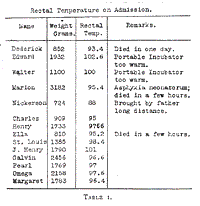
|
Table 1.
|
|
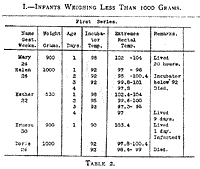
|
Table 2.
|
|
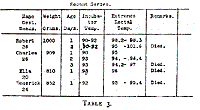
|
Table 3.
|
|
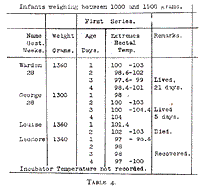
|
Table 4.
|
|
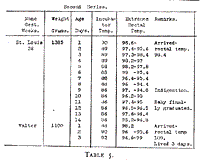
|
Table 5.
|
|
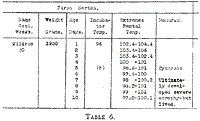
|
Table 6.
|
|
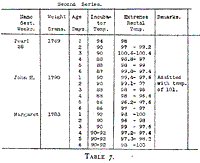
|
Table 7.
|
|
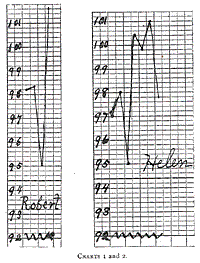
|
Charts 1 and 2.
|
|
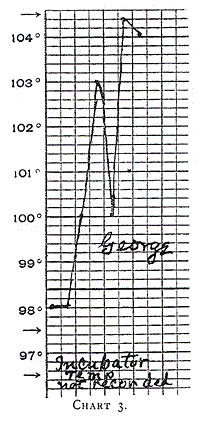
|
Chart 3.
|
|
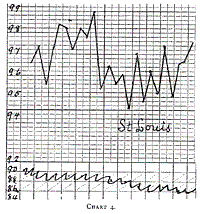
|
Chart 4.
|
|
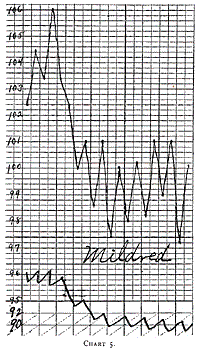
|
Chart 5.
|
|
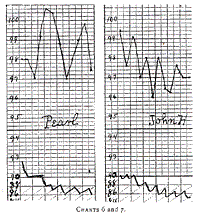
|
Charts 6 and 7.
|
(To be Continued.)
Return to the Contents Page
Created 3/3/2000 / Last modified 7/16/2020
Copyright © 2000-2020 Neonatology on the Web / webmaster@neonatology.net












